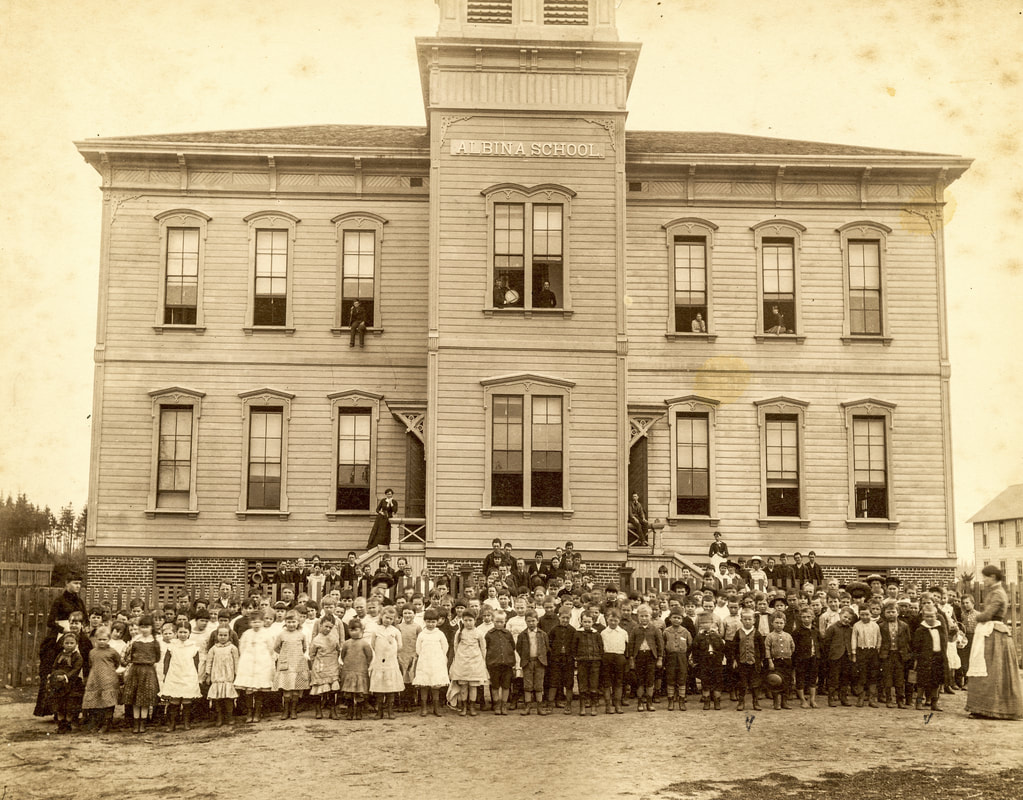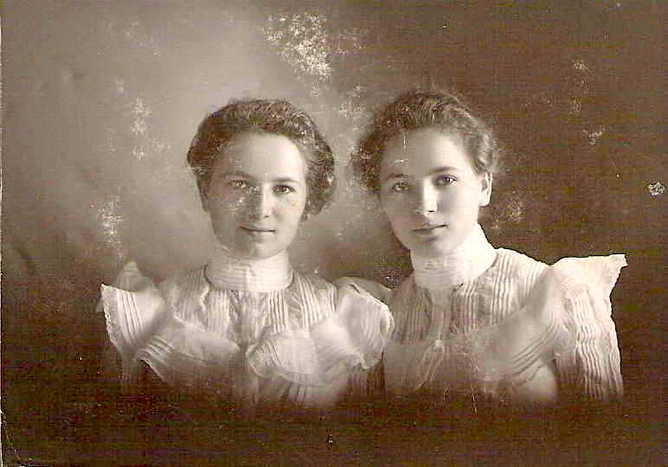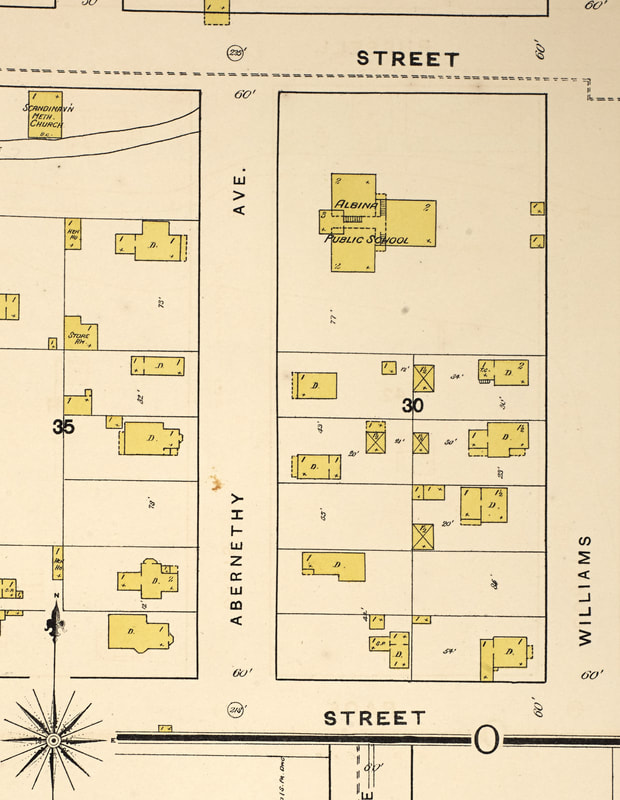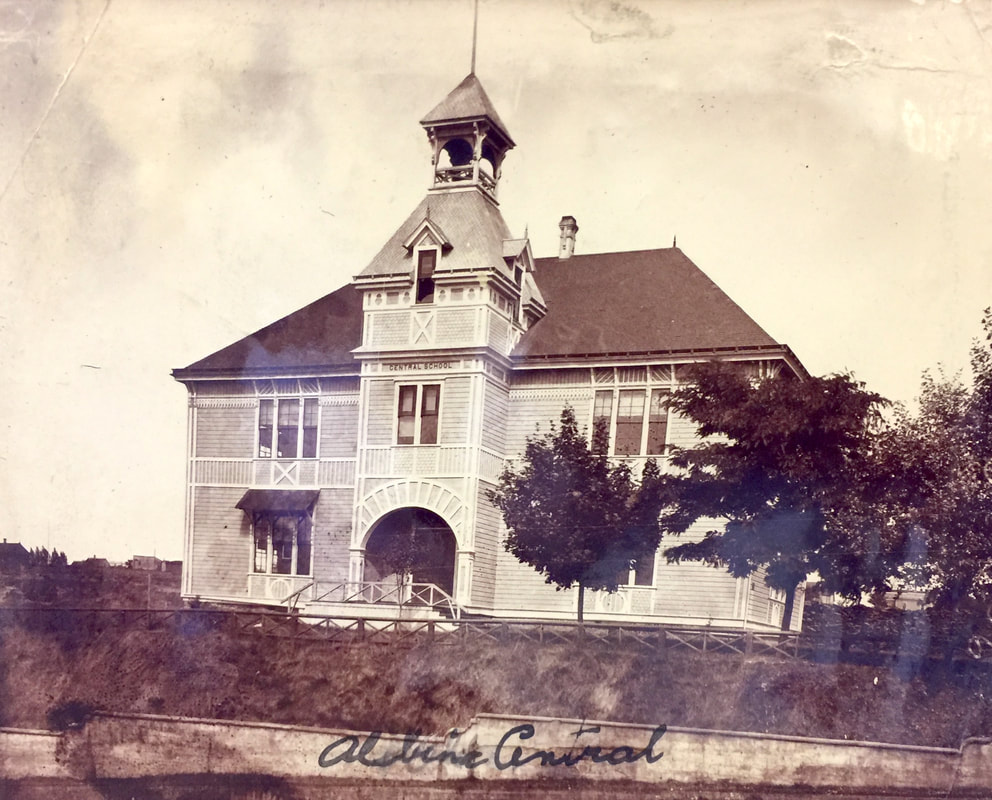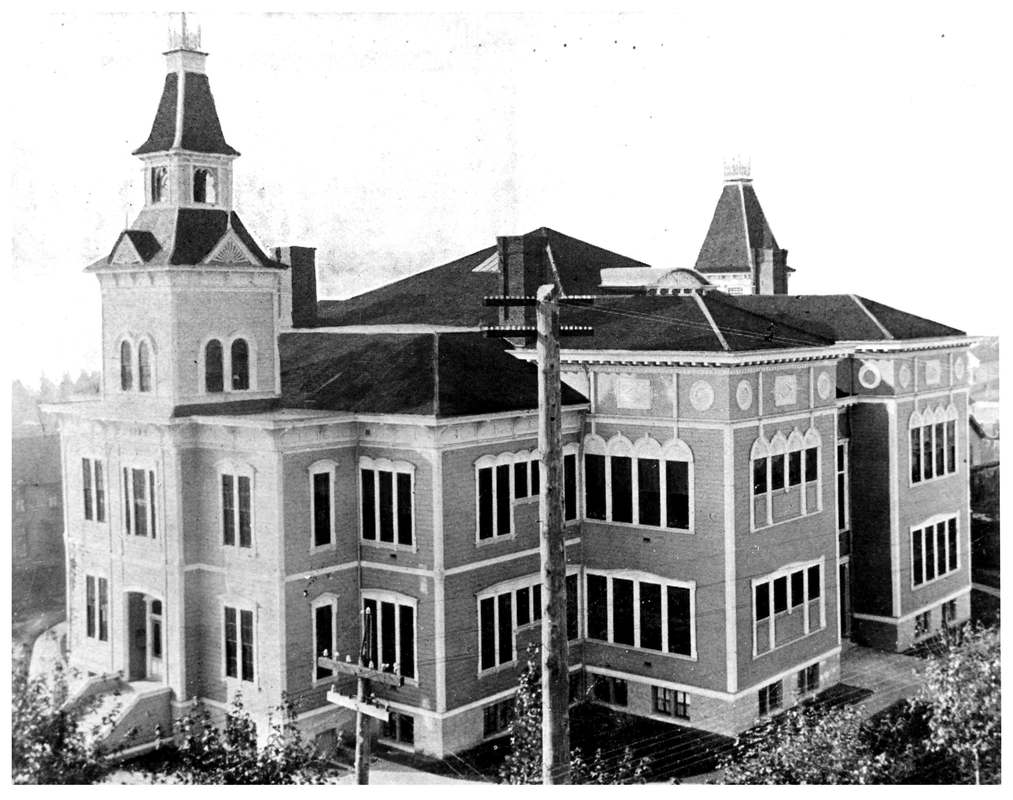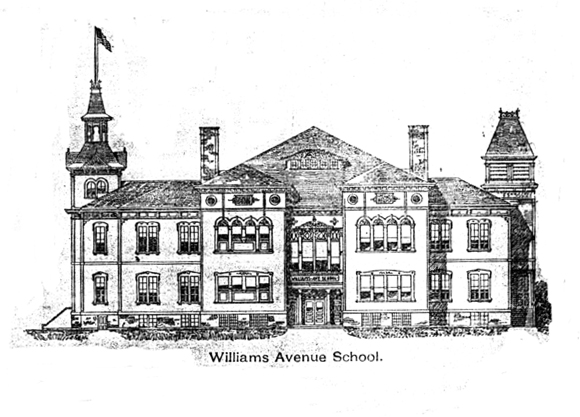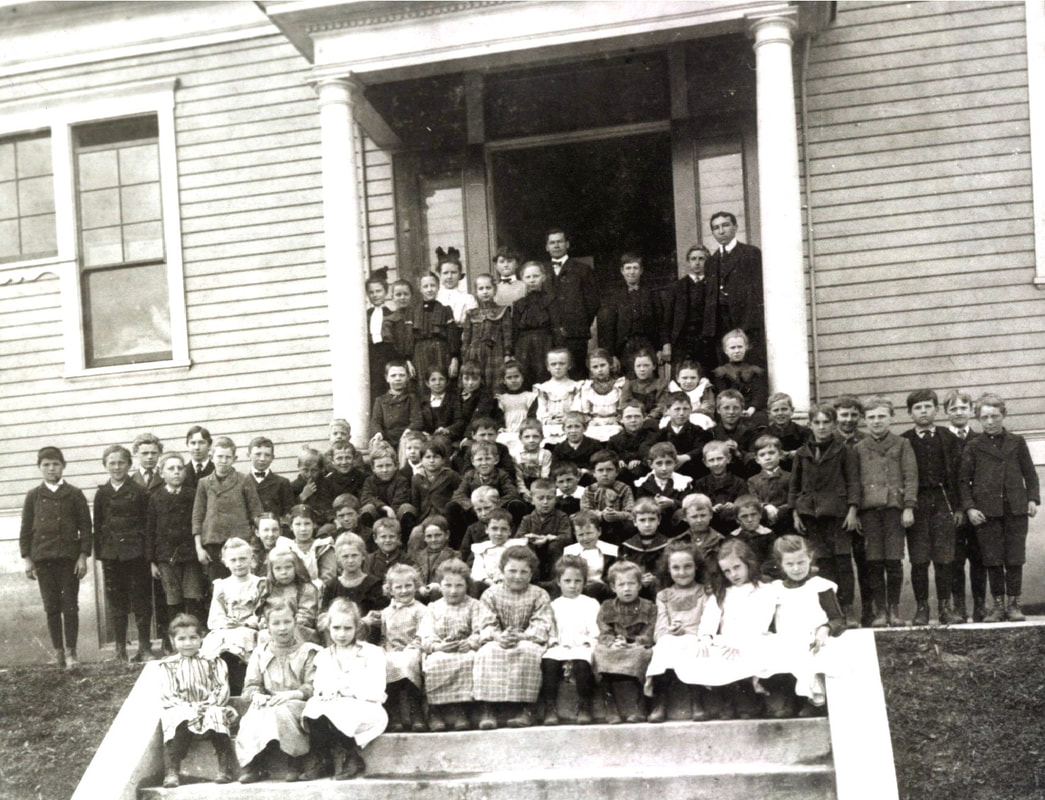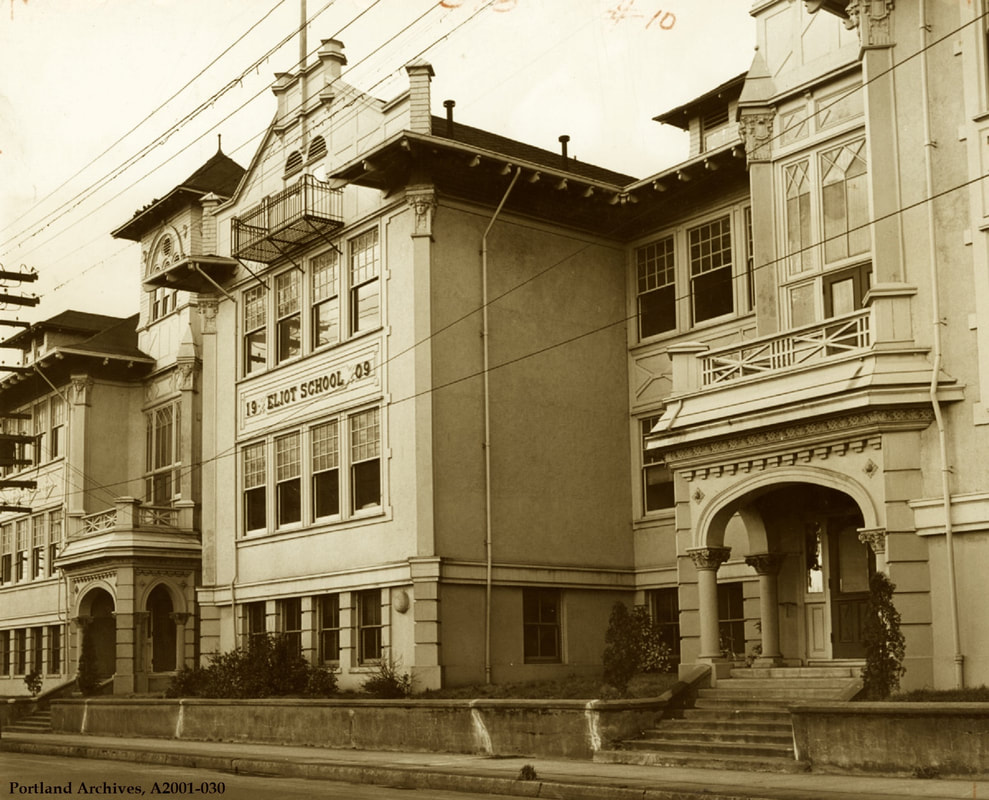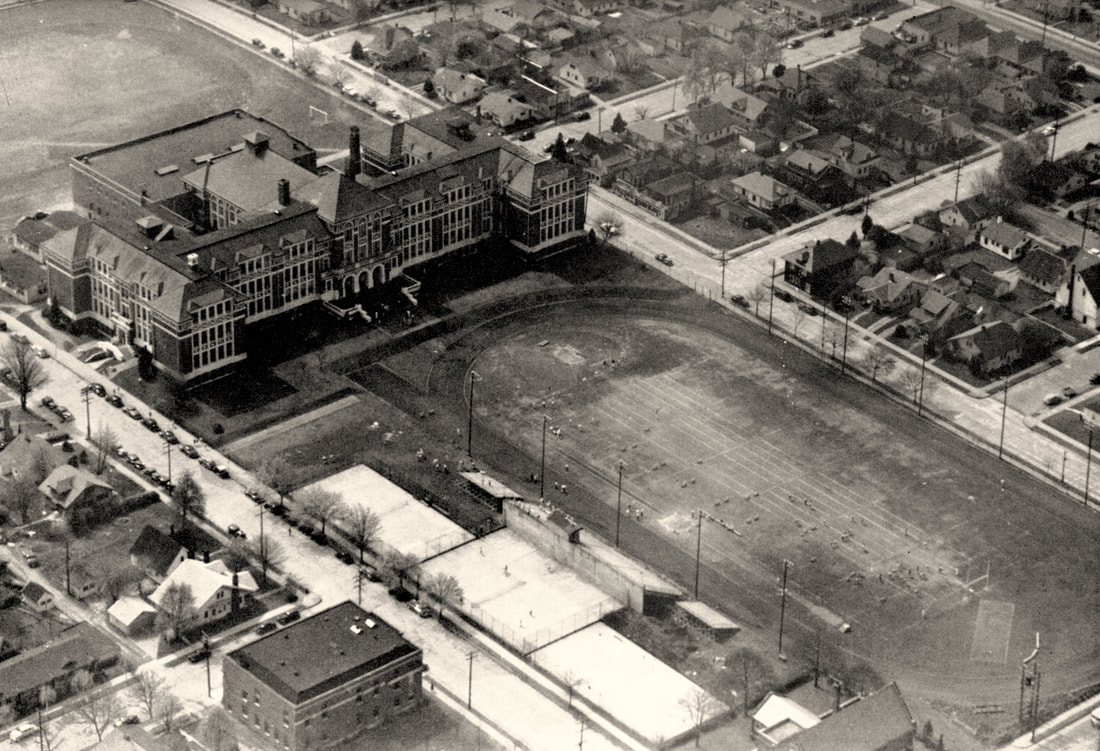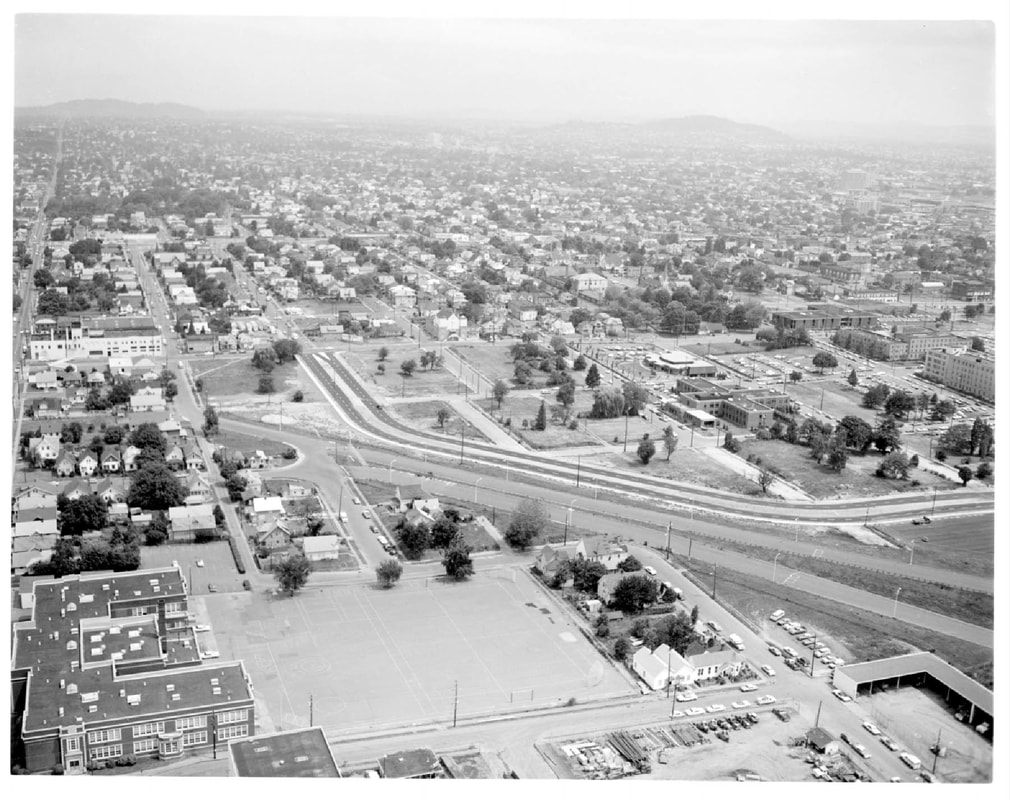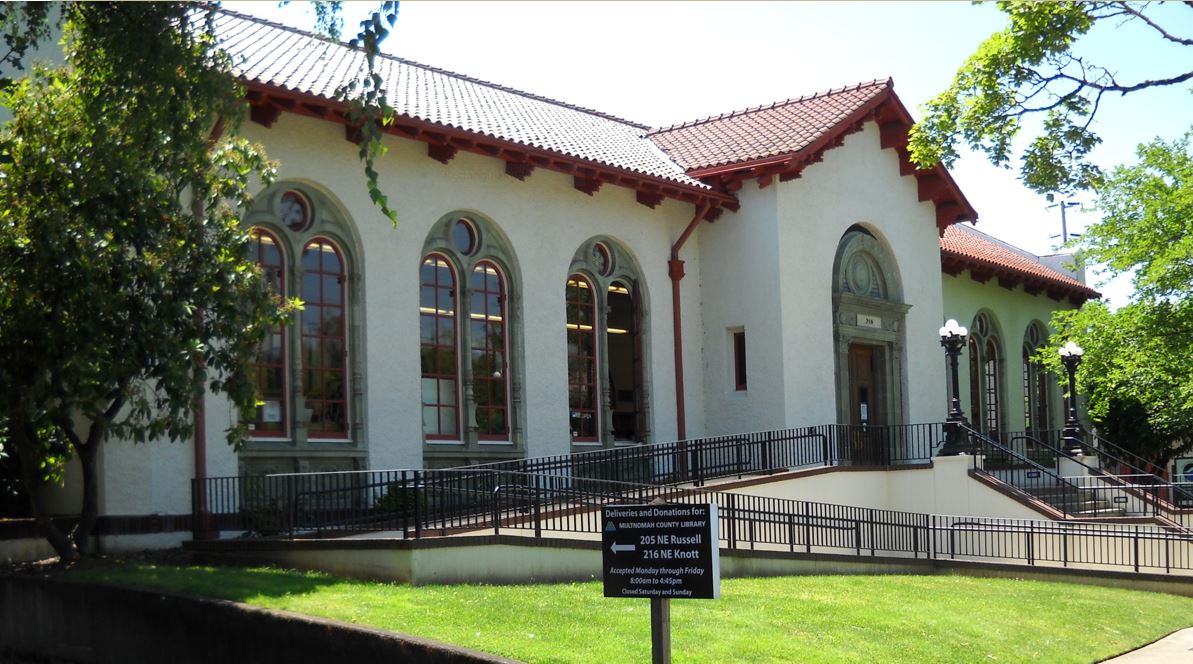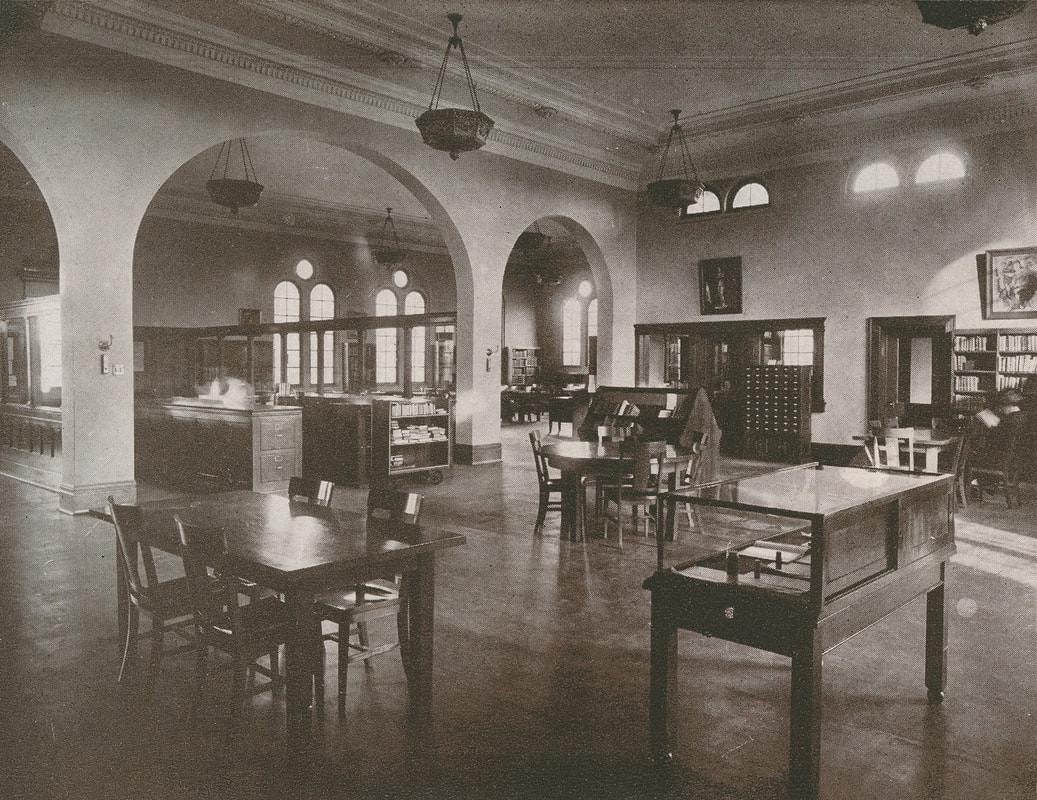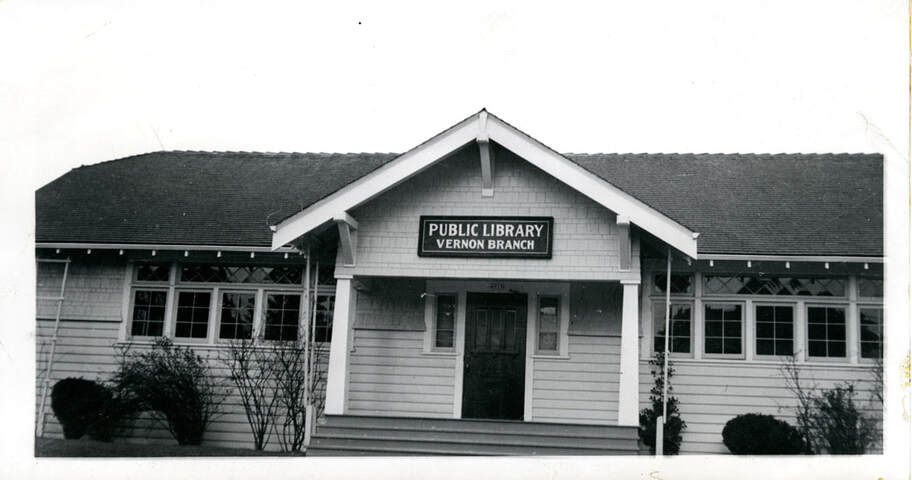Community > Education
Education
|
When the first Volga Germans arrived in Albina in 1881, there was no public school in the fledgling community. The townsite of Albina had only been established seven years earlier, in 1874. In 1880, 143 people lived in Albina, and only a small number were school-aged children.
As new families arrived, there was a growing need to provide primary education to the increasing number of children. Many were immigrants belonging to a variety of ethnic groups. The first established school in the townsite was known simply as the Albina School House, which opened in 1884. As the population of Albina proliferated, additional schools were built from the 1880s through the 1920s. |
Schools Serving the Volga German Community
|
The Volga German immigrants who settled in the neighborhoods south of the new school had low expectations for their schools. Some had encountered their first public schools after first settling in the Midwest. Those arriving directly from Russia had received the equivalent of a 6th-grade education at the German parish schools in their colony. In the church schools, they learned basic reading, writing, arithmetic, and religion.
In 1959, historian Emma Schwabenland Haynes shared the following story about her mother, Dora, Aunt Katy (a twin of Dora), and Uncle Adam, who attended the Albina School House:
"While the family was still living in the store building on Union Avenue, the twins attended school for the first time in a building located at the corner of Williams Avenue and Russell Street. The principal was Professor Pratt, and the first-grade teacher was Mrs. Wash, whose daughter Eva was also in the first grade. In order to reach the school it was necessary for the children to cross the Union Avenue car tracks, upon which a small electric train ran to Vancouver, Washington. At the present time, this whole area has been leveled off, but in 1890, there were places where the tracks lay at the bottom of a gulch and had high banks on either side. After the family moved to Morris Street, Uncle Adam and and the twins followed a footpath that ran triangularly across the large pasture and forest that lay between their home and Russell Street, because not a single street was laid out in this area."
In the early decades of settlement, Volga German students experienced several challenges at school. Most of the children were immigrants and spoke an archaic German dialect at home and in their community. It was a traumatic experience to first encounter the English language when they entered public school. Students were prohibited from speaking German during the entire school day, including recess. It was not uncommon for children to repeat a grade as they transitioned from German to English.
Adding to the tension and anxiety of participating in a new environment was the fact that their clothing and habits differed from their English-speaking or Western European neighbors. They were taunted as Rooshian kids, and fights often resulted.
It was rare that students went beyond elementary school from the early years of settlement through the early 1900s. Most children went to work to help support their families. Many of the first generation born in the United States completed some high school courses.
Many of the second and third generations completed high school and obtained college and university degrees. A number became prominent members of the community.
Adding to the tension and anxiety of participating in a new environment was the fact that their clothing and habits differed from their English-speaking or Western European neighbors. They were taunted as Rooshian kids, and fights often resulted.
It was rare that students went beyond elementary school from the early years of settlement through the early 1900s. Most children went to work to help support their families. Many of the first generation born in the United States completed some high school courses.
Many of the second and third generations completed high school and obtained college and university degrees. A number became prominent members of the community.
A Brief History of Public Schools in the City of Albina from 1883 to 1891
Construction of the first public school in Albina began in 1883. A real estate advertisement for Montgomery & Reed, placed in the August 23, 1883 edition of The Oregonian, touts homesites near the Oregon Iron and Steel Foundry, the North Pacific Terminal Company's Works, and the "new public school house." The building cost $1,200 and was known simply as the Albina School House. The two-story wood frame structure was located in the Montgomery Addition (Block 30) on Russell Street, between Abernethy Avenue (now Vancouver Avenue) and Williams Avenue. It was said that the large gilt letters on its west-facing tower proclaiming "Albina School" could be seen from a great distance. The school began educating its first students by the fall of 1884. The Albina City Directory lists Mrs. Mary as the only teacher. It was a proud moment for the fledgling townsite on the east bank of the Willamette River.
A March 19, 1886, article published in The Morning Oregonian reported strong citizen support for a proposed bond measure that would fund the construction of additional schools in Albina to support the influx of new residents. At the time, Albina was the fastest-growing city in Oregon. The growth resulted from the transcontinental railroad's completion in 1883 and the development of railroad shops, shipping docks, and other industries along the waterfront in lower Albina. These expanding businesses needed laborers and actively recruited various European immigrants, including the Volga Germans, who began arriving in 1881. As new workers flooded into Albina, they sought housing for their families and schools for their children.
In February 1887, the principal of the Albina schools, Mr. W.A. Wash, reported an enrollment of 272 pupils and requested funding for more classrooms. The number of students was well more than the seating capacity in the Albina School House. By December 1887, enrollment had already increased to 312 registered students. The school attendance rate of 96 percent was considered "excellent."
The new Albina Central School opened on Monday, January 16, 1888. The Central School was perched on the bluff, north of Morris Street between Morgan and Cardwell (now Mississippi and Albina Avenues). This location is in the southeast corner of the Cook's Addition. The design of the two-story building was similar to the Albina School House. Approximately 40 students from the most overcrowded rooms in the lowest grades of the Albina School House were transferred to the Albina Central School. Mrs. A.B. Anderson, a former Albina School House teacher, was re-engaged by the district to supervise studies in the new school.
In February 1887, the principal of the Albina schools, Mr. W.A. Wash, reported an enrollment of 272 pupils and requested funding for more classrooms. The number of students was well more than the seating capacity in the Albina School House. By December 1887, enrollment had already increased to 312 registered students. The school attendance rate of 96 percent was considered "excellent."
The new Albina Central School opened on Monday, January 16, 1888. The Central School was perched on the bluff, north of Morris Street between Morgan and Cardwell (now Mississippi and Albina Avenues). This location is in the southeast corner of the Cook's Addition. The design of the two-story building was similar to the Albina School House. Approximately 40 students from the most overcrowded rooms in the lowest grades of the Albina School House were transferred to the Albina Central School. Mrs. A.B. Anderson, a former Albina School House teacher, was re-engaged by the district to supervise studies in the new school.
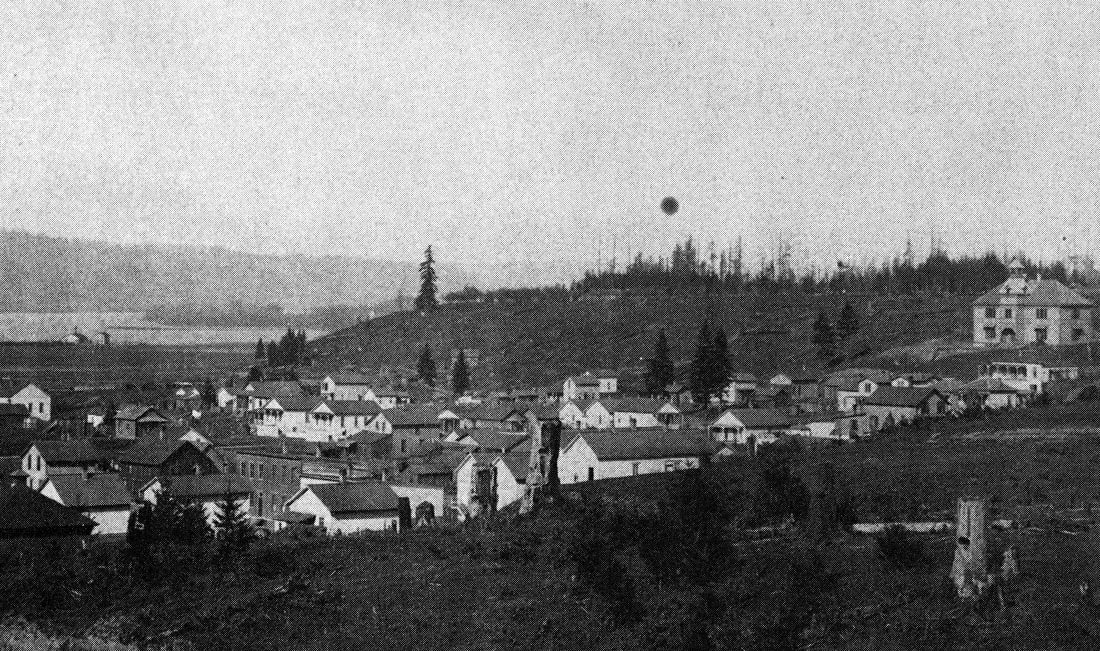
The two-story Albina Central School is shown at the far right of this photograph. The school opened in January 1888. In this photo it appears that four men are completing work on the roof which would date the image to late 1887. The view is from Russell Street near Vancouver Avenue. Given the height of the camera above the street it is likely that this photo was taken from an upper floor window of the Albina School House. Source: "Portland, Oregon - East of the Willamette River" by Donald R. Nelson.
In the spring of 1888. a third public school opened in Albina. The Multnomah School was constructed at Missouri Avenue, north of Beech Street. The school was built to serve the small number of students in the Multnomah Tract, which formed the northern part of Albina. The school was sometimes called the "North" school to distinguish it from the Albina Central School and the Albina School House located on the south side of the townsite. Miss Carrie Myers was placed in charge of the new Multnomah School.
By May 1888, aggregate enrollment in the Albina schools had increased to about 400 pupils, and the attendance rate remained at 96 percent. To accommodate the continued growth, two rooms were added to the Albina Central School, one on the first and one on the second floor.
By May 1888, aggregate enrollment in the Albina schools had increased to about 400 pupils, and the attendance rate remained at 96 percent. To accommodate the continued growth, two rooms were added to the Albina Central School, one on the first and one on the second floor.
Principal Wash, and his wife who served as a teacher and Assistant Principal, stepped down from their duties in early 1888. Prof. Carl W. Young assumed responsibility for managing the rapidly growing school district. By December 1888, registered enrollment increased to 512 students. Of this number, 298 were registered at the Albina School House, 171 at the Albina Central School, and 43 at the Multnomah School.
On December 25, 1888, The Morning Oregonian reported:
On December 25, 1888, The Morning Oregonian reported:
"Property in Albina is rapidly changing hands. To see the number of strangers walking around town and viewing property in the suburbs one would think there was a bonanza to be found."
By January 1889, there were nearly 3,000 residents in Albina, an increase of several hundred from the prior year. In June of that same year, enrollment at the three Albina public schools reached 590. Attendance remained high at 95 percent.
A March 6, 1889 article published in The Morning Oregonian states that the Albina school district board voted to increase its tax rate to fund school construction and the ongoing operation. There were three schools, 545 students, and 11 teachers at the time. A build-out of classrooms in the Albina Central School was completed during the year, and an additional classroom was planned for completion in the coming year. The resident school-age population (ages 4 to 20) was 828 and had risen by 113 in the past year.
In the summer of 1889, funds from the increased tax levy were used to build a significant addition to the Albina School House, which now contained ten classrooms, a reading room, an observatory, a library, administrative offices, and a new tower facing Williams Avenue. The cost was $6,500. The school was briefly renamed the Albina Public School, but by 1890, it was renamed the Williams Avenue School. That same year, the Albina Central School was enlarged to four classrooms. The Multnomah School continued to operate with only one classroom. Total enrollment was anticipated at over 800 students, with 16 teachers employed.
A March 6, 1889 article published in The Morning Oregonian states that the Albina school district board voted to increase its tax rate to fund school construction and the ongoing operation. There were three schools, 545 students, and 11 teachers at the time. A build-out of classrooms in the Albina Central School was completed during the year, and an additional classroom was planned for completion in the coming year. The resident school-age population (ages 4 to 20) was 828 and had risen by 113 in the past year.
In the summer of 1889, funds from the increased tax levy were used to build a significant addition to the Albina School House, which now contained ten classrooms, a reading room, an observatory, a library, administrative offices, and a new tower facing Williams Avenue. The cost was $6,500. The school was briefly renamed the Albina Public School, but by 1890, it was renamed the Williams Avenue School. That same year, the Albina Central School was enlarged to four classrooms. The Multnomah School continued to operate with only one classroom. Total enrollment was anticipated at over 800 students, with 16 teachers employed.
The first floor of the Williams Avenue School was ready for occupancy by September 1889. In November, several children of Volga German descent were reported as the select few among those holding "first position in first ranks." Those children included Katie Bower (Bauer), Rudolph Voelker, Katie Schreiber, Eva Bower (Bauer), Minnie Ross, Lizzie Leinweber and Rosie Schrantz.
Albina expressed a desire to have its own high school in December 1889. Before this time, very few children were educated beyond the eighth grade. Those who wished for more than an elementary school education were required to travel to and from Portland, a physical and monetary impediment that kept most from extending their education. The first high school established in the area, named the Portland High School, opened on April 26, 1869, in a section of Portland's North School building. Albina officials began investigating a similar use of an unused room in the former Albina School House (now part of the Williams Avenue School) to establish a high school classroom on the east side. The matter was discussed at the annual Albina City Council meeting in March 1890, but the motion to proceed failed due to the small number of potential students at that time. Public tax funds for high schools were controversial in the early 1880s. The dominant editorial voice of The Oregonian newspaper, Harvey W. Scott, strongly advocated against using public funds for high schools. His impassioned arguments ultimately failed to persuade educators and the public.
Three public schools are listed in the 1890 Albina City Directory:
- Albina Central School - located at the northeast corner of the intersection of Monroe and Mississippi.
- Multnomah School - at Missouri Avenue north of Beech Street.
- Williams Avenue School - located at the corner of Russell and Williams. between Williams and Abernethy (now Vancouver) south of Russell.
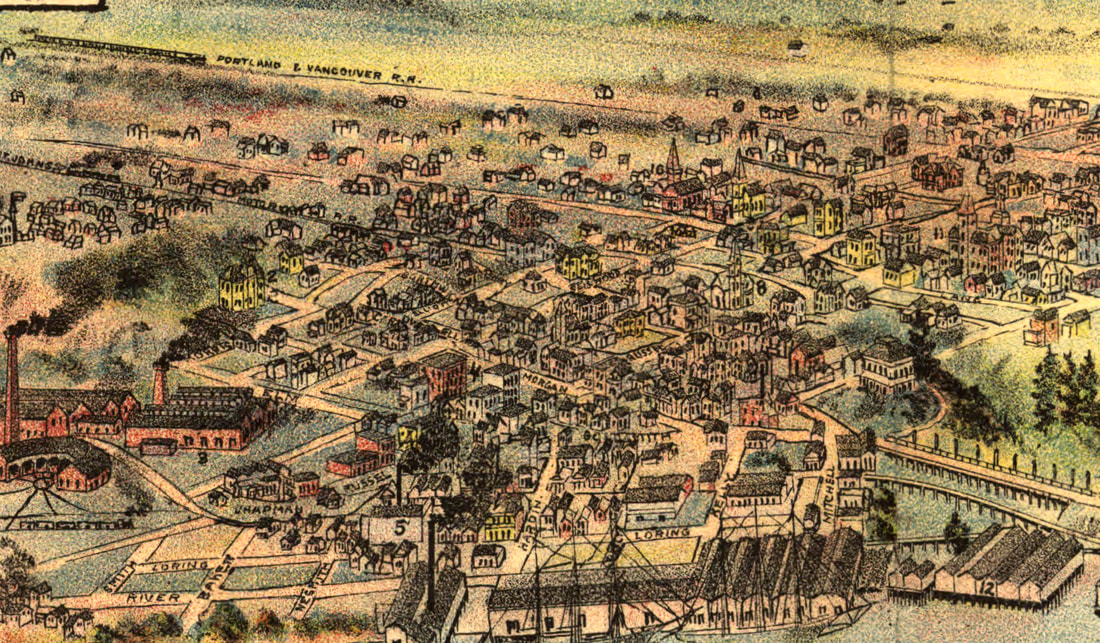
The three Albina public school are depicted in this 1890 drawing. The two-story building to the far upper-left of the image is likely the first Multnomah School. The Albina Central School (labeled #2) is located at Morris and Cardwell (now Albina Avenue). The Williams Avenue School is labeled #11 at the far right of this image (it is mislabeled as the Central School in the full map key). Image extracted from an 1890 birds eye map of Portland. Source: Clohessy & Strengele, and Elliott Pub. Co. Portland, Oregon. [San Francisco, 1890] Map. Retrieved from the Library of Congress,
The first commencement exercises for eighth-grade graduates of the Albina schools were held in 1890. There were 706 registered students as of March 28, 1890, and attendance remained around 95 percent. The district employed 14 teachers. Many articles published in The Oregonian praised Superintendent C. W. Young, his assistants, and teachers for their fine work managing the school district and obtaining excellent results, given their limited resources.
Albina continued its rapid growth. Many roads were being graded and extended. Industry continued to expand, and new housing tracts were plated in Albina. By the end of May 1890, there were over 800 students registered at the three schools.
Consolidation of the cities of Portland, East Portland, and Albina was overwhelmingly approved by voters on June 1, 1891. As a result, the school districts of Albina (No. 31) and East Portland (No. 21) were consolidated into the Portland Public School District (No. 1). The Albina Central School and the Multnomah School then served as elementary schools, and the Williams Avenue School became a high school. An editorial published in The Oregonian on June 3 stated that the outlying districts of Albina and East Portland would "receive the advantages of better schools, streets, sewers, and other needed improvements" due to the consolidation.
Albina continued its rapid growth. Many roads were being graded and extended. Industry continued to expand, and new housing tracts were plated in Albina. By the end of May 1890, there were over 800 students registered at the three schools.
Consolidation of the cities of Portland, East Portland, and Albina was overwhelmingly approved by voters on June 1, 1891. As a result, the school districts of Albina (No. 31) and East Portland (No. 21) were consolidated into the Portland Public School District (No. 1). The Albina Central School and the Multnomah School then served as elementary schools, and the Williams Avenue School became a high school. An editorial published in The Oregonian on June 3 stated that the outlying districts of Albina and East Portland would "receive the advantages of better schools, streets, sewers, and other needed improvements" due to the consolidation.
Development of Portland Public Schools in Albina from 1891 to 1950
After consolidation, rapid population growth continued in the Albina district of Portland. Construction bids for a new school in Albina were opened in June 1891, and the city surveyor laid the cornerstone that same month. By the fall of 1892, the first Albina Homestead School was completed at the corner of Mason and Williams Avenue. This school was located in the quickly developing Albina Homestead Tract. An article published in The Oregonian on November 4th states that the cost of the new school was $12,000, and the rooms were already crowded with pupils. The first Volga German church, the Ebenezer German Congregational Church, was built that same year for $1,200.
In 1893, a new Multnomah School was constructed at Shaver and Mississippi. It was sometimes referred to as the "Shaver" school.
In 1898, the Portland School District acquired land at 4906 NE 6th Street for $1,350. Buildings from the old Albina School site were moved to the property, and it became the first Highland School. After acquiring additional land in 1903, the school district constructed additions to the building in 1904, 1906, and 1909. The school board acquired other land in 1912 and erected a manual training building on the property.
The D.P. Thompson School opened about 1899 and served as an elementary school. The building was located at Borthwick and Shaver.
In 1893, a new Multnomah School was constructed at Shaver and Mississippi. It was sometimes referred to as the "Shaver" school.
In 1898, the Portland School District acquired land at 4906 NE 6th Street for $1,350. Buildings from the old Albina School site were moved to the property, and it became the first Highland School. After acquiring additional land in 1903, the school district constructed additions to the building in 1904, 1906, and 1909. The school board acquired other land in 1912 and erected a manual training building on the property.
The D.P. Thompson School opened about 1899 and served as an elementary school. The building was located at Borthwick and Shaver.
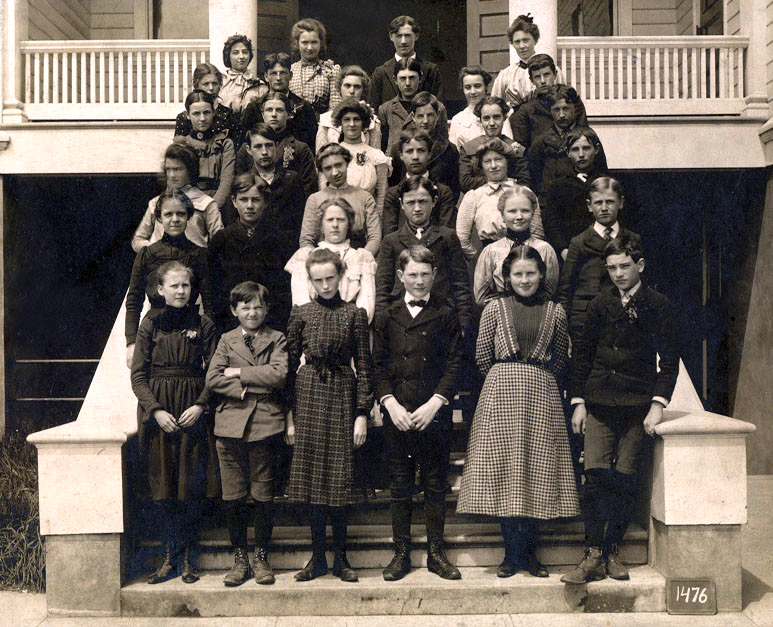
D.P. Thompson School class of 1901. Left to right beginning at the bottom:
Row 1: Esther Peterson, Albert Lish, Mary Thayer, Handel Evans, Essie (?)
Leary, Coe McKenna (?).
Row 2: Magarer Gantzen, Fred Montag, Freida Bleick, George Kennan, Sadie Johnson, George Thomas. Row 3: Olive Ralph, Victor Biersdorf, Genevive Snelling, Earnest Voelker, Nellie Church, Charles Norton. Row 4: Katy Hald, Noah Fredericks, Marie Brill, Earl Sparks, Duella Begur, Robert Gates. Row 5: Mabel Golvoson, Victor Sparks, Tillie (?) Hickey, Willie Baily, Gertrude Stoppes, George Grayson. Row 6: Selma Reimer (?), Winifred Young, Jay Kalen, Miss Sawn Myers
(Teacher). Photograph and information courtesy of Meg Drye. Meg’s grandmother, Marie Brill, is shown in this photograph.
In December 1901, the Williams Avenue School started a night school program under the leadership of Prof. J.H. Stanley.
An article published in The Oregonian on April 28, 1908, announced "Albina is Allowed Another Building." The crowded conditions in Albina necessitated building a new school on a lot bounded by Mallory, Garfield, Failing, and Beech at a cost of $21,000. The building was named the Albina Homestead School. Funds were also allocated to add four fire escapes to the Williams Avenue School to improve safety.
An article published in The Oregonian on April 28, 1908, announced "Albina is Allowed Another Building." The crowded conditions in Albina necessitated building a new school on a lot bounded by Mallory, Garfield, Failing, and Beech at a cost of $21,000. The building was named the Albina Homestead School. Funds were also allocated to add four fire escapes to the Williams Avenue School to improve safety.
In June of 1908, a plan to build a new high school to replace the Williams Avenue School was announced. The budget for the new school was $250,000. The school district planned to purchase property at Rodney Avenue and Knott Street but decided to defer until the Williams Avenue property was sold. At the same time, a plan for a six-classroom addition to the Multnomah ("Shaver") School was announced.
The new Albina Homestead School opened in October 1908, a few weeks after the regular school year began. The students temporarily attended the D.P. Thompson and Highland Schools until construction on the new building was complete. The new school derived its name from its location in the Albina Homestead Addition.
The Eliot School was opened in 1909 on property at the intersection of Rodney and Knott. The school was named after Thomas Lamb Eliot, an influential clergymen. The site was initially planned for a new high school to be named Thomas Jefferson.
The new Albina Homestead School opened in October 1908, a few weeks after the regular school year began. The students temporarily attended the D.P. Thompson and Highland Schools until construction on the new building was complete. The new school derived its name from its location in the Albina Homestead Addition.
The Eliot School was opened in 1909 on property at the intersection of Rodney and Knott. The school was named after Thomas Lamb Eliot, an influential clergymen. The site was initially planned for a new high school to be named Thomas Jefferson.
The Albina Central School was renamed the Shaver School in honor of G.W. Shaver, a co-founder of the Shaver Transportation Company. Shaver's sister-in-law, Elizabeth Dixon, was married to William Irving. The Albina Central School was closed in 1909 when the Eliot School was completed.
Construction of a new east-side high school began in 1908 to replace the Williams Avenue School. The Williams Avenue School was no longer considered safe and was too small for the growing population in the Albina district. The new school opened in September 1908 and was initially named Albina High School, but was renamed Thomas Jefferson High School in early 1909. Jefferson was the primary high school Volga German immigrants, and their descendants attended. The building is located at 5210 N. Kerby Avenue. On August 28, 1910, The Oregonian reported that the new high school was a factor in the area's rapid increase in property values, along with the car barns built by Portland Railway Light & Power Company. Lot values increased from $300 or less to a range of $3,000 to $10,000.
Construction of a new east-side high school began in 1908 to replace the Williams Avenue School. The Williams Avenue School was no longer considered safe and was too small for the growing population in the Albina district. The new school opened in September 1908 and was initially named Albina High School, but was renamed Thomas Jefferson High School in early 1909. Jefferson was the primary high school Volga German immigrants, and their descendants attended. The building is located at 5210 N. Kerby Avenue. On August 28, 1910, The Oregonian reported that the new high school was a factor in the area's rapid increase in property values, along with the car barns built by Portland Railway Light & Power Company. Lot values increased from $300 or less to a range of $3,000 to $10,000.
A rapidly growing population fueled a Portland Public School building boom during the 1920s. The school district was forced to hire additional architects to keep pace. These new buildings used a "fireproof" design incorporating brick and concrete. The Albina district was served by several of these new schools.
Jefferson became the largest high school in the state in 1922, with 2,063 students. Construction on the new President Ulysses S. Grant High School began in 1923 and opened in September 1924. Volga German children living at the eastern edge of the ethnic neighborhood, between NE 13th and NE 15th north of Fremont, typically attended Grant rather than Jefferson High School.
A new and larger Highland School was built in 1926 on the original site. Additional property was purchased in 1925, and the old wood-frame structures were demolished. The school was renamed Martin Luther King Elementary School in May 1968.
The Reuben P. Boise Grammar School was built in 1926 at 620 N. Fremont Street. The school was constructed to replace the D.P. Thompson and Shaver (formerly Albina Central) schools. It was renamed the Boise-Eliot School and later the Boise-Eliot/Humboldt School.
Jefferson became the largest high school in the state in 1922, with 2,063 students. Construction on the new President Ulysses S. Grant High School began in 1923 and opened in September 1924. Volga German children living at the eastern edge of the ethnic neighborhood, between NE 13th and NE 15th north of Fremont, typically attended Grant rather than Jefferson High School.
A new and larger Highland School was built in 1926 on the original site. Additional property was purchased in 1925, and the old wood-frame structures were demolished. The school was renamed Martin Luther King Elementary School in May 1968.
The Reuben P. Boise Grammar School was built in 1926 at 620 N. Fremont Street. The school was constructed to replace the D.P. Thompson and Shaver (formerly Albina Central) schools. It was renamed the Boise-Eliot School and later the Boise-Eliot/Humboldt School.
The R.L. Sabin Elementary School on NE 18th was constructed in 1928, drawing students from the eastern portion of the ethnic settlement area.
In the late 1940s or early 1950s, the students and teachers from the Eliot School were transferred to the Reuben P. Boise School on Fremont, and it was renamed the Boise-Eliot School. The Eliot School property was transferred to the Portland Parks Bureau in 1950 and became the Knott Street Community Center. The facility was later renamed the Matt Dishman Community Center.
In the late 1940s or early 1950s, the students and teachers from the Eliot School were transferred to the Reuben P. Boise School on Fremont, and it was renamed the Boise-Eliot School. The Eliot School property was transferred to the Portland Parks Bureau in 1950 and became the Knott Street Community Center. The facility was later renamed the Matt Dishman Community Center.
Libraries
At least two library branches have served the Albina neighborhood from the early 1900s into the 1970s. The first was known as the Albina branch. According to the Multnomah County Library website:
Albina Library's first location — a small reading room that housed about 100 books — opened in 1906, under the custodianship of Mrs. P.P. Leche. The exact location of that reading room is unknown, and circulation records for that first year do not exist today.
In September 1907, the library moved to a larger space in a vacant storeroom in the Emporium building on Williams Avenue (Note: This refers to the Emporium Outfitting Co. located at 228 Williams, now 1022 N Williams Avenue). The Library Association of Portland's annual report for 1907 states, ". . . on September 16, the branch was opened in charge of Miss Ella G. Dewart. The eagerness with which the people of Albina young and old have taken advantage of this library has been a surprise even to those who believed most thoroughly in it. It has been almost impossible to keep the shelves supplied with books."
Use of the collection continued to grow, so the library moved to larger quarters on Russell Street in 1909 (Note: The 1909 Portland City Directory lists the Albina branch address as 588 Williams Avenue, now around 2633 N Williams Avenue). By the end of the year, there were 3,149 volumes in the collection, and circulation that year increased to 36,800 items.
In 1911, a gift of nearby property and funds from the Carnegie Corporation of New York resulted in a more extensive library building at 216 NE Knott, just a block and a half from the previous site. The now historic Albina branch library was built in 1912 under the design of a young architect, Ellis F. Lawrence, who went on to design many notable buildings in Oregon. Albina was one of seven branch libraries funded in the early 20th Century by steel magnate Andrew Carnegie.
The Library Association of Portland's annual report for 1912 noted, "On October 18, 1912, the Albina branch building was ready for service, a stucco building, Spanish renaissance in design; the interior gives broad floor spaces and is well adapted to the demands of that congested district." The book collection at that time included materials in German, French, Italian, Spanish, Modern Greek, Lithuanian, Norwegian, Swedish, Russian, Polish, and Bohemian (Czech), reflecting the ethnic diversity of the neighborhood.
The Library Association of Portland's annual report for 1912 noted, "On October 18, 1912, the Albina branch building was ready for service, a stucco building, Spanish renaissance in design; the interior gives broad floor spaces and is well adapted to the demands of that congested district." The book collection at that time included materials in German, French, Italian, Spanish, Modern Greek, Lithuanian, Norwegian, Swedish, Russian, Polish, and Bohemian (Czech), reflecting the ethnic diversity of the neighborhood.
The Albina branch was closed in 1960 and reopened in several subsequent locations. The Multnomah County Library website describes these changes.
In June 1967, a new Albina Library opened in a storefront building on the corner of N. Vancouver Avenue and N. Beech Street. After the first year, circulation began to decline and continued to do so for the next ten years. In 1977, the Library Association of Portland Board voted to move the library to a new location at NE 15th Avenue and NE Fremont Street. This building first opened as a library on October 4, 1977, with Mary Jamison-Tannehill serving as its first librarian. After more than 20 years at this location, it closed on January 10, 1999 for renovation and expansion, reopening on June 22, 1999. After closure to the public due to the COVID-19 pandemic in March 2020, Albina Library relocated to its former home at 216 NE. Knott St and reopened to the public in August 2021.
In November 2020, Multnomah County voters approved a $387 million capital bond to build and transform library buildings across the county. Albina Library, which shares a site location with the library's Isom Operations Center, is scheduled to be rebuilt and significantly expanded, based on community input, reopening to the public sometime in 2024.
A second library, known as the Vernon branch, was constructed in 1917 at 4919 NE 17th, near the intersection with Alberta. The building still stands in nearly original form and currently serves as a branch of Albina Head Start.
The map below shows the location of past and current public schools attended by many Volga Germans living in NE Portland from 1884 to the early 1960s. To only see the school locations, click the icon in the upper left corner and unselect all the layers except "Schools."
Sources
Researched and written by Steven Schreiber.
"Albina. Business Lots. Residence Lots." The Morning Oregonian [Portland], August 23, 1883. Page 2.
"The East Side. Albina Water Works--The Approaching School Meeting--A Sample "Agitator"--General Notes" The Morning Oregonian, March 19, 1886. Page 3.
"The East Side. Albina Schools--Left the House--Laid to East--Sudden Death--General News." The Morning Oregonian, February 2, 1887.
"The East Side. Work of the Steam [Illegible]--Albina Public Schools--Curious Figures--New [Illegible]." The Oregonian, December 29, 1887. Page 8.
"The East Side. Albina Public Schools--Home To Be Dedicated--Personal And General Notes." The Oregonian [Portland], January 13, 1888. Page 4.
"News From The East Side Favorable Showing for the Public Schools of Albina." The Oregonian, May 10, 1888. Page 6.
"Albina News Notes. Various Matters In and About That Prosperous Little City." The Morning Oregonian [Portland], December 21, 1888. Page 3.
"Notes Around Albina. Closing Exercises of the Public School--Christmas Eve Services--Boom in Business." The Morning Oregonian [Portland], December 25, 1888. Page 3.
"Round And About Albina. Reception--Nob Chambers's Condition--Christmas Exercises--To Level the Grade--School." The Morning Oregonian [Portland}, December 31, 1888. Page 8.
"City Of Albina. Portland's Sister City Making Good Progress. A Quiet Substanitial Growth. Albina's Present." The Oregonian [Portland], January 1, 1889. Page 17.
"School Meeting At Albina A Tax of Three Mills Levied for the Ensuing Year." The Morning Oregonian [Portland], March 6, 1899. Page 3.
"Albina's News Field. Blessings From "The Oregonian" Correspondent's Note Book. [Illegible] Monthly School Report." The Morning Oregonian [Portlnad], June 3, 1889.
"News Items From Albina. Regular Meeting of the City Fathers--Routine Proceedings." The Morning Oregonian [Portland], August 24, 1889. Page 11.
"Items Sent From Albina. A Special Meeting Held by the Municipal Law Makers." The Morning Oregonian [Portland], August 26, 1889. Page 3.
"The Albina Public Schools. A Statement Made by Professor Young, the Superintendent.." The Morning Oregonian {Portland], August 31, 1889. Page 6.
"Albina News Notes. Christmas Ladder--Bad Dog Bite--Cold Bath--Charity Ball--High School Needed." The Morning Oregonian [Portland], December 23, 1889. Page 8.
"Along The East Bank. News Gathering Work of the East Portland and Albina Reporters.." The Morning Oregonian [Portland}, November 8, 1889. Page 8.
"Gathered Around Albina. The City Fathers and the Annual Meeting of the Taxpayers." The Morning Oregonian [Portland}, March 8, 1890.
"Albina's News Field. An Adjourned Meeting of tho City Law Makers." The Oregonian [Portland}, June 2, 1890. Page 10.
"After The Election Some Views as to the Results of Consolidation." The Morning Oregonian [Portland}, June 3, 1891. Page 8.
"Gets New School. Albina Is Allowed Another Building." The Morning Oregonian, April 28, 1908. Page 11.
"Values to Sailing up. Increase in North Albina in Three Years is Wonderful." The Oregonian, August 28, 1910. Page 10.
Haynes, Emma S. My Mother's People., 1959. Print.
Polich, Edward L. A history of Portland's secondary school system with emphasis on the superintendents and the curriculum. Masters thesis. University of Portland. August 1950.
Schwabauer, Wanda J. "The Portland Community of Germans from Russia." Diss. Portland State U, 1974. Print.
Albina and Portland City Directories - Ancestry.com
Annual Report of School District No. 1, Multnomah County, Oregon, Including the City of Portland, for the Year Ending June 21, 1910.
Multnomah Country Library website. "Albina Library history". Accessed 12 August 2022.
"Albina. Business Lots. Residence Lots." The Morning Oregonian [Portland], August 23, 1883. Page 2.
"The East Side. Albina Water Works--The Approaching School Meeting--A Sample "Agitator"--General Notes" The Morning Oregonian, March 19, 1886. Page 3.
"The East Side. Albina Schools--Left the House--Laid to East--Sudden Death--General News." The Morning Oregonian, February 2, 1887.
"The East Side. Work of the Steam [Illegible]--Albina Public Schools--Curious Figures--New [Illegible]." The Oregonian, December 29, 1887. Page 8.
"The East Side. Albina Public Schools--Home To Be Dedicated--Personal And General Notes." The Oregonian [Portland], January 13, 1888. Page 4.
"News From The East Side Favorable Showing for the Public Schools of Albina." The Oregonian, May 10, 1888. Page 6.
"Albina News Notes. Various Matters In and About That Prosperous Little City." The Morning Oregonian [Portland], December 21, 1888. Page 3.
"Notes Around Albina. Closing Exercises of the Public School--Christmas Eve Services--Boom in Business." The Morning Oregonian [Portland], December 25, 1888. Page 3.
"Round And About Albina. Reception--Nob Chambers's Condition--Christmas Exercises--To Level the Grade--School." The Morning Oregonian [Portland}, December 31, 1888. Page 8.
"City Of Albina. Portland's Sister City Making Good Progress. A Quiet Substanitial Growth. Albina's Present." The Oregonian [Portland], January 1, 1889. Page 17.
"School Meeting At Albina A Tax of Three Mills Levied for the Ensuing Year." The Morning Oregonian [Portland], March 6, 1899. Page 3.
"Albina's News Field. Blessings From "The Oregonian" Correspondent's Note Book. [Illegible] Monthly School Report." The Morning Oregonian [Portlnad], June 3, 1889.
"News Items From Albina. Regular Meeting of the City Fathers--Routine Proceedings." The Morning Oregonian [Portland], August 24, 1889. Page 11.
"Items Sent From Albina. A Special Meeting Held by the Municipal Law Makers." The Morning Oregonian [Portland], August 26, 1889. Page 3.
"The Albina Public Schools. A Statement Made by Professor Young, the Superintendent.." The Morning Oregonian {Portland], August 31, 1889. Page 6.
"Albina News Notes. Christmas Ladder--Bad Dog Bite--Cold Bath--Charity Ball--High School Needed." The Morning Oregonian [Portland], December 23, 1889. Page 8.
"Along The East Bank. News Gathering Work of the East Portland and Albina Reporters.." The Morning Oregonian [Portland}, November 8, 1889. Page 8.
"Gathered Around Albina. The City Fathers and the Annual Meeting of the Taxpayers." The Morning Oregonian [Portland}, March 8, 1890.
"Albina's News Field. An Adjourned Meeting of tho City Law Makers." The Oregonian [Portland}, June 2, 1890. Page 10.
"After The Election Some Views as to the Results of Consolidation." The Morning Oregonian [Portland}, June 3, 1891. Page 8.
"Gets New School. Albina Is Allowed Another Building." The Morning Oregonian, April 28, 1908. Page 11.
"Values to Sailing up. Increase in North Albina in Three Years is Wonderful." The Oregonian, August 28, 1910. Page 10.
Haynes, Emma S. My Mother's People., 1959. Print.
Polich, Edward L. A history of Portland's secondary school system with emphasis on the superintendents and the curriculum. Masters thesis. University of Portland. August 1950.
Schwabauer, Wanda J. "The Portland Community of Germans from Russia." Diss. Portland State U, 1974. Print.
Albina and Portland City Directories - Ancestry.com
Annual Report of School District No. 1, Multnomah County, Oregon, Including the City of Portland, for the Year Ending June 21, 1910.
Multnomah Country Library website. "Albina Library history". Accessed 12 August 2022.
Last updated October 21, 2023
